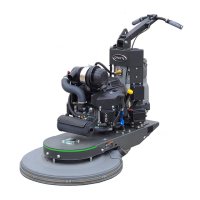44 45
MEASURING CARBON MONOXIDE EXPOSURE
WARNING: Deployment of a monitor/detector is essential for the safe operation of any
equipment that has the potential to produce carbon monoxide.
CO sensors/detectors became available on the mass market around 1978. The main dierences between
the technologies involved are battery or electric and Semiconductor or Biomimetic types. Detectors for
carbon monoxide (CO) are manufactured and marketed for use in either the home or occupational indus-
trial settings. The detectors for home use are devices that will sound an alarm before CO concentrations
in the home become hazardous. There is an Underwriters Laboratories, Inc., performance standard (UL
2034) for residential CO detectors. Detectors currently available on the market are battery-powered, plug-
in, or hardwired. Some models incorporate a visual display of the parts per million (ppm) concentration of
CO present in the home. For more information on CO detectors for home use, call the Consumer Product
Safety Commission:
Commission Hotline at 1-800-638-2772
CO detectors for use in residential settings are not designed for use in workplace settings.
Monitoring requirements in an occupational setting are dierent from monitoring requirements in the
home. In the workplace, it is frequently necessary to monitor a worker’s exposure to carbon monoxide over
an entire work shift and determine the time-weighted average (TWA) concentration of the exposure. It
may also be necessary to have carbon monoxide monitors with alarm capabilities in the
workplace. The direct reading instruments are frequently equipped with audio and/or visual alarms and
may be used for area and/or personal exposure monitoring. Some have microprocessors and memory for
storing CO concentration readings taken during the day. It is signicant to note that some of the devices
mentioned for workplace CO monitoring are not capable of monitoring TWAs, and not all are equipped
with alarms. The appropriate monitor must be chosen on an application-by-application basis. For more
information on the availability of workplace CO monitors or their application, call the National Institute
for Occupational Safety and Health at 1-800-35-NIOSH (1-800-356-4674).
UNDERSTANDING FACTORS THAT DETERMINE
CARBON MONOXIDE LEVELS
The primary factors that ultimately determine the expected level of Carbon Monoxide in a space where a
propane machine is operating are as follows:
• Room air volume
• Air Exchange Rate (ventilation rate)
• Carbon Monoxide Production Rate
Room air volume can be determined by multiplying the length, width, and height of a room, and then
reducing for any material in the room. For example:
A room that is 100 ft x 100 ft with a 10 ft ceiling has a volume of: 100 x 100 x 10 = 100,000 cubic feet,
when empty. If the room consists of 80% open air, and 20% material, the total room air volume =
100,000 * 80% = 80,000 cubic feet.
UNDERSTANDING FACTORS THAT DETERMINE
CARBON MONOXIDE LEVELS
Air Exchange Rate is a measure of the room’s ventilation. Air exchange rate is typically measured in terms
of the qty of air changes per hour (ACPH). In other words, the Air Exchange Rate when expressed as ACPH,
measures the frequency (per hour) that the room’s air is replaced by fresh air. The higher the ACPH, the
more frequently air is being ventilated, for example:
In a room with ACPH = 6, the room’s air would be completely extracted and replaced by fresh air 6 times
every hour, or once every 10 minutes.
Here are some air exchange rates, expressed in ACPH, that would be expected in dierent types of industri-
al and commercial spaces:
Basement Parking
Residential Basement
Bedroom
Residential Bathroom
Residential Living Rooms
Residential Kitchen
Residential Laundry
Business Oces
Business Lunch Break Rooms
Business Conference Rooms
Business Copy Rooms
Computer Rooms
Restaurant Dining Area
15–30
3–4
5-6
6-7
6-8
7-8
8-9
6-8
7-8
8-12
10-12
10-14
8-10
Restaurant Food Staging Area
Restaurant Bar
Public Hallway
Public Retail Store
Public Foyer
Church
Public Auditorium
Commercial kitchens & Restrooms
Smoking rooms
Laboratories
Classrooms
Warehousing
10-12
15-20
6-8
6-10
8-10
8-12
12-14
15–30
15-20
6–12
3–4
3-10
Carbon Monoxide Production Rate is, itself, the result of several factors:
• The total ow of engine exhaust, which is determined by the relative amount of engine load of application
• The amount of Carbon Monoxide present in the exhaust, expressed as PPM
• The quantity of propane engines in operation
A 603cc propane engine under normal operating conditions (50% of maximum load) will produce total
exhaust at a rate of 13 CFM (cubic feet per minute), with Carbon Monoxide making up 50 PPM of the total
exhaust.
Therefore, the CO production rate (in CFM) is calculated as follows:
Qty of Engines * Exhaust Flow per Engine (CFM) * CO Level of Exhaust (PPM)
Calculating the CO production rate of one 603cc engine operating under normal conditions is as follows:
1 engine * 13 cubic ft / min per engine * 50 / 1,000,000 = 0.00065 cubic feet/min
Knowing all of these factors, we can calculate the equilibrium carbon monoxide level of a room (in PPM) as
follows:
Total CO production rate (in cubic feet / min) * Air Exchange Rate (expressed in minutes) *
1,000,000 Room air volume (in cubic feet)

